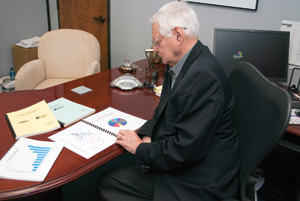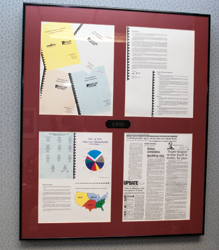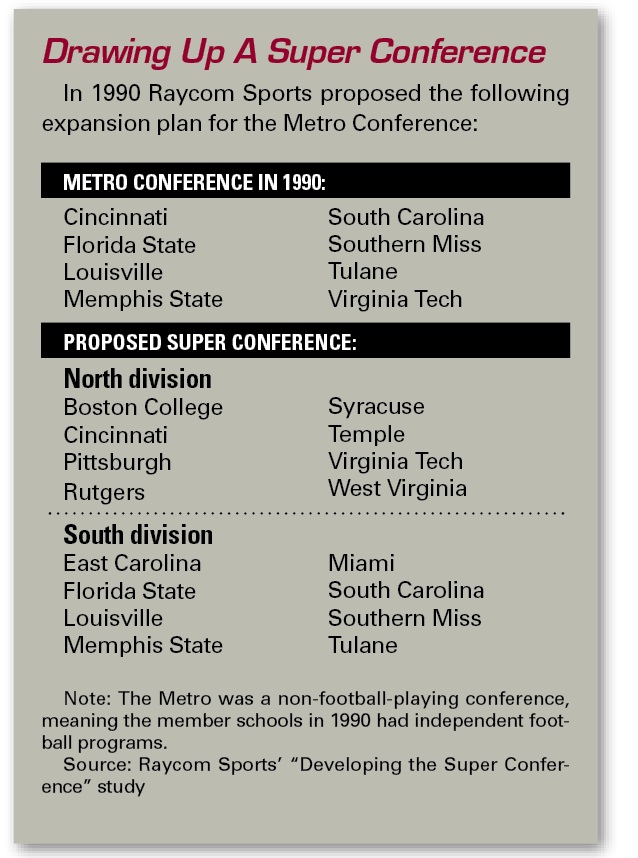The idea was to create a super conference of 16 schools overlapping states from the Northeast through the South. Eventually, according to this plan, there would be four super conferences that blanketed the country, and their champions would come together in a playoff to decide the national champ in college football.
“Developing the Super Conference” was the name of the booklet that first proposed the idea in 1990, and its 240 pages held the future of college athletics. It’s just that no one knew how long it would take to get there.
That plan, the first to suggest the super-conference model as the best way to maximize a league’s value, was written by Charlotte-based Raycom Sports for the now-defunct Metro Conference. From that, the concept of a super conference and its merits were born. Based on where conference expansion now appears to be headed, it was an idea well ahead of its time.
“At that point, the super-conference concept made so much sense to us,” said Ken Haines, the CEO of Raycom Sports and one of the authors of the report. “We felt like the idea would be captured and implemented by all of the major conferences. We just didn’t know when.”
It was January 1990 when the Metro Conference commissioned Raycom Sports, its media partner, to craft a plan that would help solidify the league’s future. At the time, institutions came and went from the Metro, which ranged from six to nine schools during its run from 1975 to 1995. It wasn’t unlike the fluidity that the current-day Big East has experienced in recent years.
 |
TIFFIN WARNOCK / STAFF
Says Raycom Sports CEO Ken Haines, with the original plan: “We felt like the idea would be … implemented by all of the major conferences. We just didn’t know when.” |
The Metro, under the guidance of Commissioner Ralph McFillen, had a base of charter schools from urban areas, such as Louisville, Cincinnati, Memphis and Tulane. But the basketball-centric conference didn’t sponsor football and it needed to grow if it intended to survive against the heavies of that time: the SEC, ACC, Southwest Conference, Big Eight, Big Ten and Pac-10.
McFillen asked Raycom how to do that.
Raycom, the dominant TV production company and syndicator of that day, had deals with the Big Eight, Southwest Conference, Big Ten and ACC. It spent six months developing the super-conference model, taking into account TV households, conference footprint, alumni bases, regional rivalries and institutional compatibility. The 240 pages included everything from mock schedules and average attendance in football to SAT scores for each school.
Raycom’s plan called for the Metro to expand to 16 football-playing schools with two eight-team divisions or four four-team divisions, similar to what has been discussed by the ACC, the Pac-12 and others in recent weeks. It was compelling enough that at one point that spring in 1990, presidents and ADs from all 16 schools met in Dallas to talk it through.
“It would have changed the face of college athletics,” said Dave Hart, who attended that meeting as the AD at East Carolina, and now serves as the AD at Tennessee. “But the presidents just couldn’t get their arms around it. There were several people who understood the vision and were really excited, but they were outnumbered by those who were just terrified of something so radical. Nobody had ever heard of a super conference before.”
According to Raycom’s plan, the Metro’s members would have come from the North (Boston College, Syracuse, Pittsburgh), the South (Miami, Florida State, South Carolina) and moved west through the middle of the country (Louisville, Memphis, Cincinnati). The original plan also included Penn State, but the Nittany Lions committed to the Big Ten before Raycom could finish the project.
At the time, those schools were independents in football, so the super conference would not have been raiding schools from other conferences, as leagues do now.
The Metro’s footprint would have accounted for more than 35 percent of the nation’s TV households, putting it on par with the Big Ten, while maintaining traditional rivalries, such as Miami-Florida State, by keeping them in the same division. The new structure of the super conference theoretically would have commanded the largest TV dollars available because of its sheer size and the markets it covered.
“A lot of what’s happening now reminds me of 1990,” said Bill Olsen, who back then was the athletic director at Louisville. “Most of us were strongly in favor of doing this and we thought it had a lot of potential. It definitely made the SEC and the ACC stand up and take notice. It got their attention.”
In a 1990 story in USA Today that explored the possibility of massive college realignment, Haines was quoted as saying the super-conference model is “cutting edge. … What you’re going to see within the next five years will form the fabric of college sports for the next 50 years.”
Haines missed his five-year assessment, but he was prescient in his estimation that it could form the fabric for the next 50 years. Recently, Cedric Dempsey, the NCAA’s former president and now a college consultant, said this latest round of realignment puts the major college conferences on a path toward creating their own division, perhaps separate from the NCAA.
The six major conferences “for a long time have thought they could govern themselves,” Dempsey said. “I wouldn’t be surprised if that’s where we end up, with five or six super conferences that form their own organization.”
In 1990, the super-conference model was grounded in the same basics that are driving conferences to expand now. It went after major markets, it increased the conference footprint to include multiple regions of the country, and it would have captured a significant number of the nation’s TV households. The divisional format maintained geographical rivalries, while the larger conference stretched up and down the East Coast.
“I always felt the super-conference concept would happen at some point, even though this particular model didn’t happen,” Haines said. “This all came about 21 years ago because of the pressure to generate revenue and fund programs. It’s no different today.”
The super-conference idea didn’t work out for the Metro. A year after the study, in 1991, Florida State ended up going to the ACC, South Carolina joined Arkansas as new members of the SEC, and the Big East began playing football, which gave Syracuse, Boston College, Pittsburgh, Virginia Tech and Miami a conference home for football.
Many of the other Metro members migrated to a new league called Conference USA.
“If we had been able to create that super conference, I think it would have turned into four super conferences nationally,” Olsen said. “But it never became a reality.”
Well, not yet.






